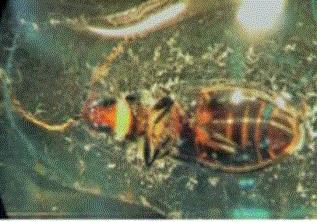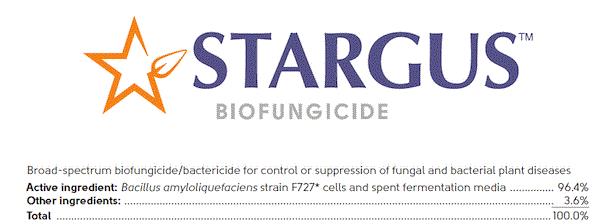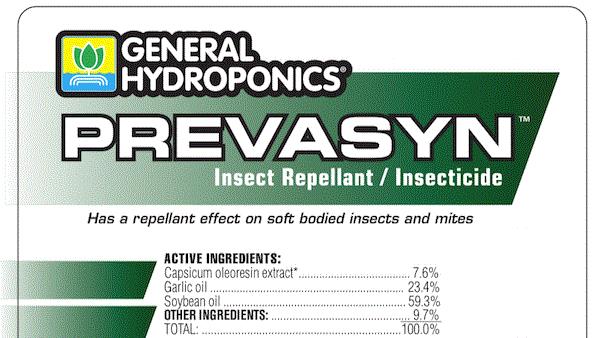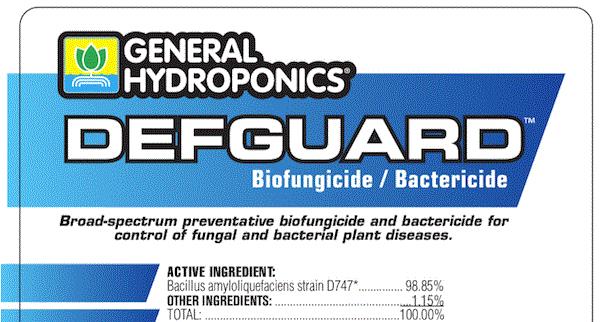New nematode species against redheaded flea beetle
Frank Hale of the University of Tennessee forwarded a press release from USDA ARS about Shawn Steffan’s (of ARS’s Vegetable Crops Research Unit in Madison, Wisconsin) recent research on using two native nematode species for managing cranberry pests. One of these pests is the redheaded flea beetle.
I’ve been working with redheaded flea beetle for the past few years. Y’all, these beetles just won’t quit! You can kill the beetles feeding on your paniculata hydrangea pretty easily, but there are many more to take their dead brethrens’ places on the buffet table. None of the foliar-applied insecticides achieved more than a week of repellence in my trials, so growers have to spray repeatedly whenever the beetles are active.
An alternative option is to reduce the population of larvae in the pots and surrounding fields, so that there are fewer adults emerging and damaging the leaves. Among the commercially available nematode species, Steinernema carpocapsae seems to have a little higher efficacy. Even then, greater efficacy against larvae is needed to make a substantial dent in adult populations and damage.
That’s why the research by Shawn Steffan is so interesting to me. Shane Foye of University of Wisconsin and Shawn Steffan recovered two nematode species, Oscheius onirici and Heterorhabditis georgiana, in Wisconsin’s cranberry fields. The researchers then conducted pathogenicity studies in the field and the laboratory, where both nematode species achieved about 65% suppression of emerging flea beetles. In a controlled arena study, O. onirici reduced the number of emerging adult flea beetles by more than 60% compared to the untreated arena, whereas diazinon and clothinidin achieved slightly (but not significantly) lower adult beetle numbers. This research was published in Volume 138 of the scientific journal Biological Control.

Nematodes emerging from a dead redheaded flea beetle. (Photo credit: Shane Foye and Shawn Steffan 2019; Biological Control 138: 104042)
Unfortunately, the nematodes ain’t ready for sale at this time. There's still lots of research (such as more field trials on different crop systems) and development (such as finding the most suitable formulation) to be done. But, I’m eager to see if these new nematode species can become additional tools in the battle against redheaded flea beetles.
Frank sent the press release to me in the first week of December. I wonder if he received the article while slapping cranberry sauce on turkey? Nope, you won't see cranberry sauce on my turkey; cranberry tastes too much like cough syrup to me. (I know I’m weird.) And, give me that bird fried. (Don't you dare show this newsletter to my physician!)

Boxwood health workshop coming up
Do you grow or manage boxwood? Are you battling or concerned with boxwood blight? If so, here is an educational opportunity for you.
AmericanHort, Horticultural Research Institute and Oregon Association of Nurseries will present a full-day workshop on boxwood blight management. The Boxwood Health Workshop will be held at Oregon State University’s North Willamette Research and Extension Center in Aurora, Oregon, on February 4, 2020.

Speakers at the workshop are experts from universities, USDA, Oregon Department of Agriculture, and a major boxwood producer. Topics to be covered during the workshop include
-
Resistant cultivar testing for boxwood blight
-
Management approaches against boxwood blight
-
Grower insights on how to start clean and stay clean
-
Nursery surveys and boxwood cleanliness programs in Oregon
-
Efforts in preventing the introduction of box tree moth
Register early because space is limited to 50 people. The registration fee is $50, which includes lunch. Pesticide recertification credits will be available for California, Oregon and Washington.
For more information about the workshop and to register, click here.
Ten new pesticides approved for hemp
Growers of industrial hemp will have additional pest management tools for the next growing season. EPA approved ten new pesticides for use on industrial hemp this week. I wrote about the review of nine biopesticides and one conventional pesticide in a November issue of this newsletter.
Four insecticides are registered by Agro Logistics Systems. These insecticides are Debug-ON (70% neem oil), Debug Optimo (15.04% neem oil + 0.7% azadirachtin), Debug Trés (4.7% neem oil + 3% azadirachtin) and Debug Turbo (65.8% neem oil + 0.7% azadirachtin). A wide variety of insects and mites is listed on the product labels, including some common hemp pests such as mites, aphids, caterpillars and leaf beetles. Use sites include various agricultural, greenhouse and turf sites.

Marrone Bio Innovation registered two biofungicides. Regalia Bioprotectant Concentrate contains 5% extract of Reynoutria sachalinensis, or giant knotweed. EPA also approved the addition of hemp to the use site of products with the EPA Registration Number 84059-28, which includes biofungicides Stargus, Amplitude and Amplitude ST, all of which contain 96.4% Bacillus amyloliquefaciens strain F727. These fungicides control a wide range of fungal and bacterial diseases, including powdery mildew, phytophthora, rhizoctonia and botrytis.


Hawthorne Hydroponics registered two insecticides and a fungicide under its General Hydroponics brand. Prevasyn (7.6% capsicum oleoresin extract + 23.4% garlic oil + 59.3% soybean oil) is an insecticide and repellent against soft-bodied insects and mites. AzaMax contains 1.2% azadirachtin for management of a wide range of insect and mite pests. Defguard is a biofungicide containing 98.85% Bacilus amyloliquefaciens strains D747, and is used against fungal and bacterial diseases.
The three companies haven’t released revised labels with hemp listed as a use site.



Atrazine re-registration moves forward
EPA also issued an interim registration review decision this week, proposing the renewal of atrazine registration. Atrazine is perhaps one of the most widely used herbicides in agronomic crops, such as corn and sorghum. We may not use a lot of atrazine in the nursery, but the herbicide is a major weed management tool in landscape and turf.
In 2016, EPA concluded in a draft assessment that atrazine poses risks to aquatic plants, fish, amphibians, mammals, birds and reptiles. In another draft assessment published in 2018, EPA concluded that cumulative exposure to atrazine through food, water and residential uses poses reproductive and developmental risks to children. EPA proposes mandatory spray drift control and allowable amount in residential lawns. However, environmental groups argued that the protection for children from these measures is not sufficient, and recommend banning all residential uses of atrazine.
EPA also proposes an increase of allowable level of concern for aquatic organisms from 10 ppb to 15 ppb. When the atrazine level exceeds the 15-ppb threshold, herbicide registrants will be required to work with state and local watershed programs to conduct watershed-based mitigation. Environmental groups point out that the proposal will allow 50% more atrazine to enter America’s waterways, and accuse the EPA of ignoring decades of research and putting children and community health at risk.
Prior to completing the re-registration process, EPA will continue to work with the U.S. Fish and Wildlife Service and the National Marine Fisheries Service to assess the impact of atrazine on threatened and endangered species.
EPA will be taking public comments for 60 days, and issue its final decision next summer. Expect lots of fiery arguments during the review process.
If your in-laws drive you crazy this holiday season, print a copy of the EPA interim decision for yourself. Find a quiet corner, and pretend that you are reading a very important document. I won't tell anyone that you’re actually taking a nap.






Happy holidays! I'll see y'all in 2020.

JC Chong
Professor of Entomology at Clemson University
This e-mail received by 22,731 subscribers like you!
If you're interested in advertising on PestTalks contact Kim Brown ASAP!